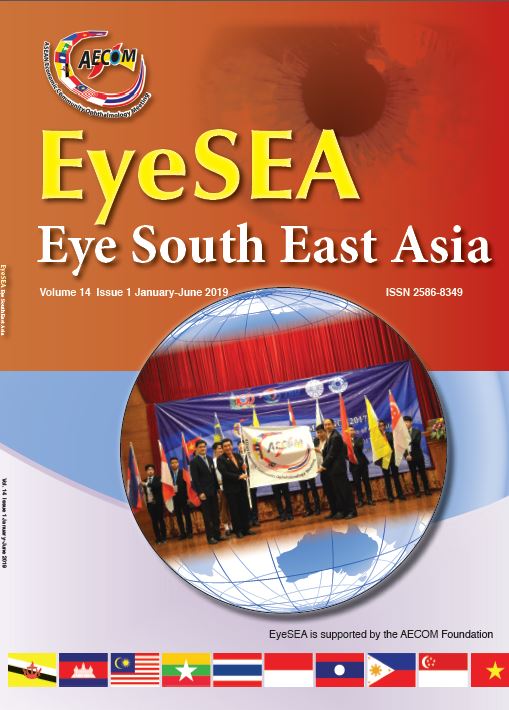Clinical characteristics and surgical outcome of eyelid ptosis at tertiary eye hospital A retrospective study
Main Article Content
Abstract
Background: Ptosis is a common upper eyelid problem which can be seen in children and adult. Ptosis can cause amblyopia in younger patients and reduce visual field in older patients.
Objectives: To determine the prevalence and clinical characteristic of ptosis and to evaluate surgical outcome of eyelid ptosis.
Methods: In this descriptive-retrospective study, 490 medical records of patients who admitted to Jakarta Eye Center Hospital between 2014 and 2016 with diagnosis of eyelid ptosis were included in this study. Prevalence rates, patient’s demographic, clinical characteristic, type of therapy, successful rate and complication of ptosis surgery were evaluated.
Results: The prevalence of ptosis in this study was 490 patients and was more frequent in men aged 44.5 years old. The ptosis was predominantly unilateral 79.6%. Ptosis was mild in 33.5% cases and myogenic ptosis was the most common etiology of ptosis in this study. Levator resection is the most prevalent type of surgery. The success rate of ptosis surgery was 91.8%.
Conclusion: The success rate of ptosis surgery in this study was high and undercorrection was the most common complication of ptosis surgery.
Conflict of Interest: There is no conflicting relationship exists for any author.
Article Details
References
2.Griepentrog GJ, Diehl NN, Mohney BG. Incidence and demographic of childhood ptosis. Ophthalmology. 2011;118:1180-3.
3.Baiyeroju AM, Oluwatosin OM. Blepharoptosis in ibadan, nigeria. West Afr J Med. 2003;22(3):208-10.
4.American Academy of Ophthalmology. Periocular malpositions and involutional changes. In: Orbit, Eyelids and Lacrimal system. San Fransisco. 2012;7:201-13.
5.Balasubrahanian K, Mathiyalagan S. A prospective study of aponeurotic ptosis and its management at tertiary eye hospital. International Journal of Oncology and Oculoplastic. 2017;3(1):29-32.
6.Skaat A, Fabian ID, Spierer A, Rosen N, Rosner M, Simon GJB. Congenital ptosis repair-surgical, cosmetic, and functional outcome: a report of 162 cases. Can J Ophthalmol. 2013;48(2):93-8.
7.Abrishami A, Bagheri A, Salour H, Aletaha M, Yazdani S. Outcomes of levator resection at tertiary eye care center in iran: a 10-year experience. Korean J Ophthalmol. 2012;26(1),1-5.
8.Hashemi H, KhabazKhoob M, Yekta A, Mohammad K, Fotouhi A. The prevalence of eyelid ptosis in tehran population: the tehran eye study. Iranian Journal of Ophthalmology. 2010;22(1):3-6.
9.Gonzalez-Esnaurrizar G. The epidemiology and etiology of ptosis in a ophthalmic center. Inves Ophtalmol Vis Sci.
2008;49(13):640.
10.Jordan DR, Anderson RL. The aponeurotic approach to congenital ptosis. Ophthalmic Surg. 1990;21(4):237-44.
11.Cates CA, Tyers AG. Outcomes of anterior levator resection in congenital blepharoptosis. Eye (Lond). 2001;15:770-3.


